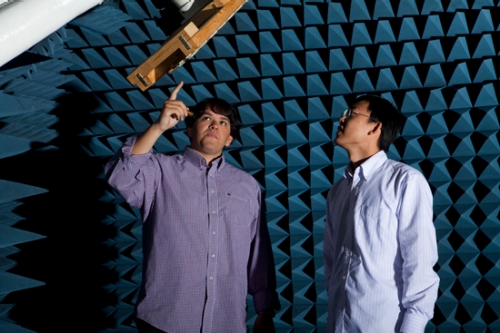Christopher Thajudeen, Ph.D. Student, Wins Best Student Paper of FEKO International Competition
Christopher Thajudeen, a Ph.D. student working in the Antenna Research Lab (ARL) within the Center for Advanced Communications (CAC), took top honors at the international 2010 FEKO Student Competition, sponsored by the creators of a leading electromagnetic simulation software tool, for his paper entitled “From Electrically Small Ultra-Wideband Antennas to Large Scale Building Imaging; Using FEKO to Synthesize Full Building Through-the-Wall Radar Imaging Scenarios.”
“I’m honored to be chosen the winner of a competition that drew entries from around the world and to be recognized by the members of FEKO,” says Thajudeen, who received a $2,000 prize.
Although he primarily works with Dr. Ahmad Hoorfar, Professor and Director of the ARL, and Dr. Wenji Zhang, a postdoctoral researcher, the interdisciplinary nature of Thajudeen’s research connects him with many other members of the CAC, including CAC Director Dr. Moeness Amin, and Dr. Fauzia Ahmad, Director of the Radar Imaging Lab.
With funding from the Defense Advanced Research Projects Agency, Thajudeen focuses his research on the phenomenology associated with electromagnetic waves as they propagate through building materials, such as concrete, cinder block, and drywall, to collect data on intended targets. His goal is to develop algorithms that will compensate for the distortion that hinders through-the-wall radar imaging (TWRI) systems from producing accurate images of these targets. He is also designing low-profile, wideband antennas for use with TWRI systems that will be lightweight, low-profile, and cost-effective while operating over a very wide range of frequencies.

With the majority of the analytical and numerical simulation components of his research complete, Thajudeen is currently performing experiments designed to provide data that verifies results he has obtained. “This process entails multiple experimental setups to test the robustness of my through-the-wall radar imaging algorithms and, separately, the sensors,” says Thajudeen. “If these experiments perform as expected, I will then integrate the algorithmic and hardware components into a prototype system for either an unmanned autonomous vehicle or a handheld TWRI platform.”
Thajudeen plans to graduate with his Ph.D. by May 2012 and pursue a career in industry for antennas and electromagnetic research and development. His goal is to acquire industry experience before returning to academic research in the future.
